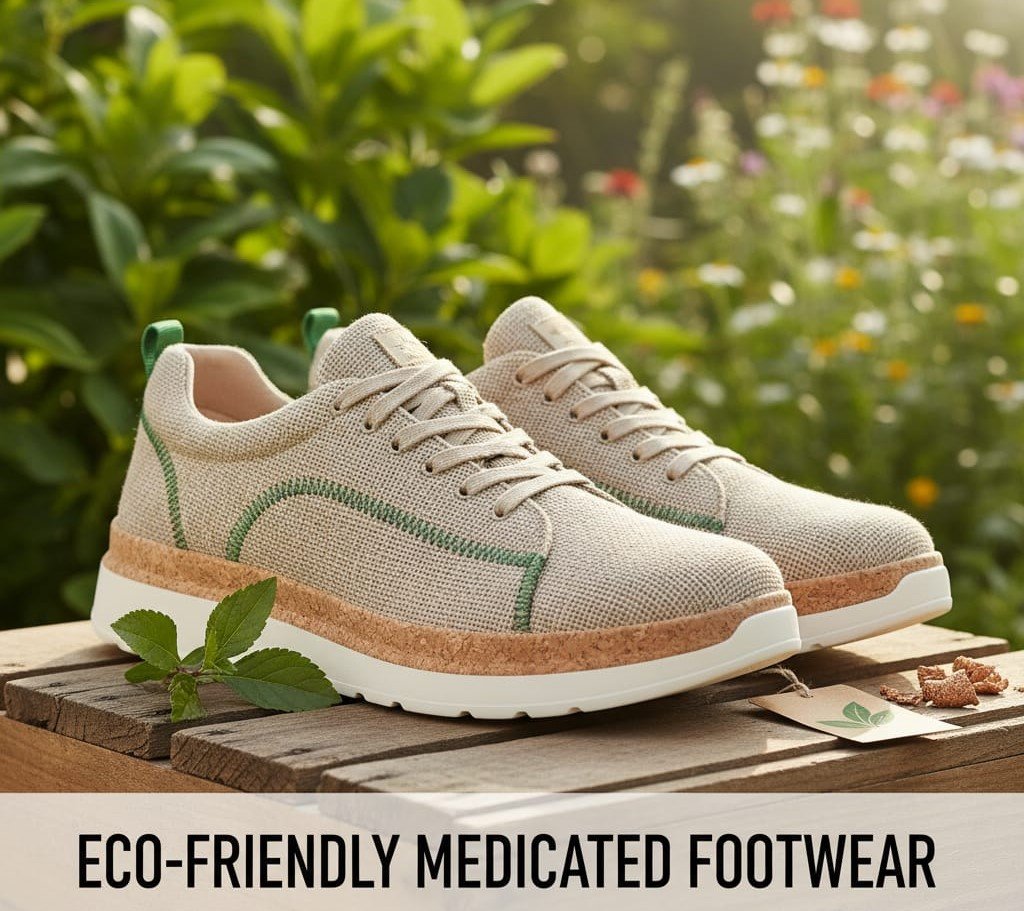🦶 Introduction – When Foot Health Meets Planet Health
In today’s world, choosing the right footwear isn’t only about comfort or style — it’s about making a choice that supports your body and the environment. For those who rely on therapeutic or “medicated” footwear (for foot pain, orthotic support, plantar fasciitis, diabetic foot care, etc.), there’s a growing opportunity to select shoes that do both: provide medical‑grade support and eco‑conscious design.
In this article we’ll dive into how eco‑friendly materials, sustainable manufacturing, and thoughtful design are converging with medicated footwear to create the new standard of style + support. You’ll learn what to look for, why it matters, and how to choose shoes that honor your feet and the planet.
🌿 Why Sustainability Matters in Medicated Footwear
Sustainability isn’t just a buzzword. The footwear industry has long been resource intensive — from raw material extraction (leather, rubber, synthetics) to manufacturing processes (dyeing, adhesives, solvents) and end‑of‑life disposal.
For people who use medicated shoes (often wearing them many hours, every day), the stakes are higher:
- You want shoes that last longer (reducing waste and cost).
- You want materials that are non‑irritating, breathable, and safe — especially if you have foot sensitivity or conditions like diabetes.
- You want ethical production, so you’re not compromising one part of your wellness by harming another.
Research shows that sustainable footwear materials (such as recycled rubber, plant‑based leathers, and renewable foams) are gaining serious traction.
Additionally, consumers (especially Millennials and Gen Z) increasingly expect brands to demonstrate environmental knowledge, ethical production, and activism — all of which influence purchase behavior.
🧬 What “Medicated Footwear” Means — And How Eco‑Fits In
Medicated footwear refers to shoes that are designed with therapeutic considerations: arch and heel support, cushioning, deeper soles, orthotic compatibility, and often produced with medical or podiatric insight.
Eco‑friendly footwear, on the other hand, emphasizes materials and processes that minimize environmental impact: recycled content, plant‑based alternatives, low‑waste production, ethical labor.
When these two come together, you get footwear that supports your foot health and supports a better world. But there are key things to check — because “eco” alone doesn’t guarantee “medicated” support, and “medicated” alone doesn’t guarantee “sustainable”.
🏗️ Key Features to Look For in Eco‑Friendly Medicated Shoes
1. Arch & Heel Support with Sustainable Materials
- Look for firm arch support, deep heel cups, motion‑control midsoles — essential features of medicated footwear.
- At the same time, check if midsoles/outsoles are made from recycled rubber, bio‑based foams, or natural rubber–jute composites. For example, research shows rubber–jute composites can offer durability and sustainability.
- Avoid shoes that claim “eco” but skimp on structural support.
2. Breathable, Non‑Toxic Uppers & Linings
- For eco shoes: Vegan leathers (such as pineapple‑leaf “Piñatex”, mushroom leather), hemp/organic cotton uppers, low‑impact dyes. For medicated shoes: Uppers should allow airflow, reduce heat/moisture build‑up, and minimize irritation (important if you have foot conditions).
- Choose shoes that combine both.
3. Orthotic Compatibility & Removable Insoles
- Medicated footwear often includes removable insoles so you can insert custom orthotics or upgraded supports.
- In an eco‑friendly version, check that the insole materials themselves are sustainably sourced (e.g., recycled foams or natural cork) and designed for long‑term durability.
4. Durability, Longevity & Circularity
- The most sustainable shoe is the one you keep for longer. Brands highlight durable build, repairability, and take‑back or recycling programs.
- Medicated shoes tend to cost more — but if they last twice as long, they serve both your foot health and the environment.
5. Transparent & Ethical Production
- Eco‑friendly claims require proof: look for transparency about material sourcing, labor practices, and environmental certifications.
- Medicated brands often disclose podiatrist involvement, biomechanical design, and medical testing.
🔍 Popular Eco‑Friendly Materials in Footwear & Why They Matter
| Material | Eco Advantage | Why It Works for Medicated Shoes |
|---|---|---|
| Recycled rubber outsoles | Reduces landfill waste, cuts virgin rubber production. | Provides strong grip & durability for therapeutic footwear. |
| Plant‑based leathers (Piñatex, Mycelium) | Lowers leather’s environmental footprint. | Gives a premium finish while maintaining foot‑friendly structure. |
| Hemp, Organic cotton uppers | Lower water/pesticide footprint; breathable. | Breathability helps foot conditions (heat, moisture). |
| Natural rubber–jute composites | New sustainable composite with durability. | Suitable for midsoles or footbeds requiring support. |
| Bio‑based foams/sugar‑cane EVA | Lower fossil fuels, lighter weight. | Helps reduce foot fatigue in supportive shoes. |
👟 Style Meets Support — Examples of Design Trends
- Look for sleek silhouettes that don’t scream “medical shoe” — eco medicated footwear is blending into lifestyle/fashion wear.
- Colorways and finishes matter: earthy tones, minimalist trims, vegan leather textures.
- Modular or hybrid designs: A shoe with removable support elements, durable yet stylish uppers, and materials that tell a sustainable story.
- Collaboration lines (therapeutic × sustainable brands) are becoming more common.
🧾 How to Choose the Right Eco‑Friendly Medicated Shoe (Step‑By‑Step)
- Identify your foot condition/need — plantar fasciitis, flat feet, diabetic foot, standing all day, etc.
- Set your budget — eco medicated shoes may cost more, but consider lifespan and health value.
- Check support specs — arch depth, heel cup, sole rigidity, orthotic compatibility.
- Inspect materials and sustainability claims — recycled content %, plant‑based components, manufacturing ethics.
- Fit & comfort test — same as any medicated shoe: fit at end of day, walk around flooring, check heel stability, arch feel, width.
- Lifecycle & warranty — check if brand offers repair, recycling, or trade‑in programs.
- Style — you’ll wear them more if you like how they look. Sustainability + support + style = best combination.
🌎 The Real Impact of Wearing Eco‑Medicated Footwear
- Foot Health: Proper support reduces pain, prevents further damage, improves posture.
- Environmental Health: Less waste, fewer virgin materials, ethical production.
- Consumer Influence: By choosing sustainable therapeutic footwear, you send a message to manufacturers and the industry. The study “Unpacking Eco‑Conscious Footwear” shows brand activism + environmental knowledge drive adoption.
- Long‑Term Value: Durability + support = fewer replacements, fewer injuries, lower cost over time.
✅ Final Thoughts – Walking Into a Greener Future
If you require medicated footwear (for plantar fasciitis, other foot ailments, or just long‑day foot support) you don’t have to compromise style or the planet. The convergence of eco‑friendly materials and therapeutic design means you can get footwear that supports your body and supports the Earth.
When you next shop for your next pair:
- Prioritize structural support and sustainable credentials.
- Don’t settle for “eco” that lacks spine or “medicated” that lacks conscience.
- Remember: foot health is lifestyle, and lifestyle is planet health.
Your feet—and our planet—will thank you.

